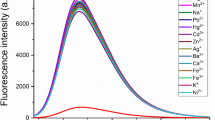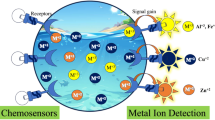Abstract
Cuprous ion is an essential element for human life activities. However, excessive cuprous can cause dysfunction of the human body system. To help explain this evolving biology, we report a fluorescent probe for detecting unstable Cu(I). Cu(I) undergoes a metal complexation reaction with the sulfur element in the probe, resulting in a photoelectron transfer (PET) effect. The probe fluorescence is greatly suppressed, and rapid and selective visual detection of Cu(I) in the inorganic environment is realized. There is also a good linear relationship between the probe fluorescence intensity and the Cu(I) concentration (R2 = 0.992), which can realize the quantitative detection of Cu(I). When the probe concentration is 0.1 μM, the detection limit is 15 nM, and the detection limit of the visual method is as low as 0.1 μM. This work provides a valuable starting point for real-time monitoring of the Cu(I) concentration in a human anaerobic environment based on active probes.
Graphical abstract






Similar content being viewed by others
References
J. Chayen, Cell. Biochem. Fun. 13(2), 153 (1995)
P.G. Ridge, Y. Zhang, V.N. Gladyshev, PLoS ONE 3, 1 (2008)
E.L. Que, D.W. Domaille, C.J. Chang, Chem. Rev. 108(5), 1517 (2008)
A.K. Boal, A.C. Rosenzweig, Chem. Rev. 109(10), 4760 (2009)
L. Band, I. Bertini, S. Ciofi-Baffoni, T. Kozyreva, K. Zovo, P. Palumaa, Nature 465, 645 (2010)
C.J. Chang, Nat. Chem. Biol. 11(10), 744 (2015)
S.C. Dodani, D.W. Domaille, C.I. Nam, E.W. Miller, L.A. Finney, S. Vogt, C.J. Chang, Proc. Natl. Acad. Sci. USA. 108(15), 5980 (2011)
R.H. Crabtree, J. Inorg. Nucl. Chem. 40, 1453 (1978)
X. Duan, E. Block, Z. Li, T. Connelly, J. Zhang, Z. Huang, X. Su, Y. Pan, L. Wu, Q. Chi, Proc. Natl. Acad. Sci. USA. 109(9), 3492 (2012)
L. Krishnamoorthy, J.A. Cotruvo, J. Chan, H. Kaluarachchi, C.J. Chang, Nat. Chem. Biol. 12(8), 586 (2016)
T. Finkel, M. Serrano, M.A. Blasco, Nature 448(7155), 767 (2007)
K.J. Barnham, A.I. Bush, Chem. Soc. Rev. 43(19), 6727 (2014)
S.G. Kaler, Nat. Rev. Neurol. 7(1), 15 (2011)
J.L. Burkhead, L.W. Gray, S. Lutsenko, Biometals 24(3), 455 (2011)
U. Merle, M. Schaefer, P. Ferenci, W. Stremmel, Gut 56(1), 115 (2007)
A.C. Joseph, T.A. Allegra, M.R. Karla, J.C. Christopher, Chem. Soc. Rev. 44(13), 4400 (2015)
K.P. Carter, A.M. Young, A.E. Palmer, Chem. Rev. 114, 4564 (2014)
A.T. Aron, K.M. Ramos-Torres, J.A. Cotruvo, C.J. Chang, Acc. Chem. Res. 48(8), 2434 (2015)
C.J. Fahrni, Curr. Opin. Chem. Biol. 17(4), 656 (2013)
M.C. Heffern, H.M. Park, H.Y. Au-Yeung, D. Van, C.M. Ackerman, A. Stahl, C.J. Chang, Proc. Natl. Acad. Sci. USA. 113(50), 14219 (2016)
E.L. Que, C.J. Chang, Chem. Soc. Rev. 39(1), 51 (2009)
E.L. Que, C.J. Chang, J. Am. Chem. Soc. 128(50), 15942 (2006)
E.L. Que, E. Gianolio, S.L. Baker, A.P. Wong, S. Aime, C.J. Chang, J. Am. Chem. Soc. 131(24), 8527 (2009)
S. Park, H.J. Kim, J. Hypertens. 9(33), 4473 (2012)
I. Tsujikawa, E. Kanda, The 573rd report of the Research Institute for Iron, Steel and Other Metals, P420 (Tohoku University, Japan, 1950)
W. Zeng, X. Yang, X. Chen, Y. Yan, Eur. Polym. J. 61, 309 (2014)
Y. Fu, C. Liu, S. Pu, Sens. Actuators B 239, 295 (2017)
F. Ma, M. Sun, K. Zhang, Y. Zhang, H. Zhu, L. Wu, D. Huang, S. Wang, RSC Adv. 4(104), 59961 (2014)
Acknowledgements
The work was financially supported by the National Key Research and Development Program of China (2017YFA02070000), the National Natural Science Foundation of China (21775042).
Author information
Authors and Affiliations
Corresponding author
Additional information
Advanced Publication Released Online by J-STAGE September 10, 2021.
Supplementary Information
Below is the link to the electronic supplementary material.
Rights and permissions
About this article
Cite this article
Yin, R., Yu, L., Su, P. et al. Fluorescent probe visualization for selective detection of cuprous ion. ANAL. SCI. 38, 145–150 (2022). https://doi.org/10.2116/analsci.21P218
Received:
Accepted:
Published:
Issue Date:
DOI: https://doi.org/10.2116/analsci.21P218




